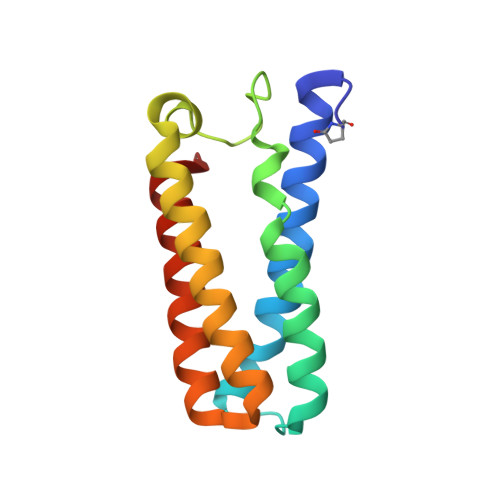Carbon Monoxide Poisoning is Prevented by the Energy Costs of Conformational Changes in Gas- Binding Haemproteins.
Antonyuk, S.V., Rustage, N., Petersen, C.A., Arnst, J.L., Heyes, D.J., Sharma, R., Berry, N.G., Scrutton, N.S., Eady, R.R., Andrew, C.R., Hasnain, S.S.(2011) Proc Natl Acad Sci U S A 108: 15780
- PubMed: 21900609
- DOI: https://doi.org/10.1073/pnas.1109051108
- Primary Citation of Related Structures:
2YKZ, 2YL0, 2YL1, 2YL3, 2YL7, 2YLD, 2YLG, 2YLI, 3ZQV, 3ZQY, 3ZTM, 3ZTZ, 3ZWI - PubMed Abstract:
Carbon monoxide (CO) is a product of haem metabolism and organisms must evolve strategies to prevent endogenous CO poisoning of haemoproteins. We show that energy costs associated with conformational changes play a key role in preventing irreversible CO binding. AxCYTcp is a member of a family of haem proteins that form stable 5c-NO and 6c-CO complexes but do not form O(2) complexes. Structure of the AxCYTcp-CO complex at 1.25 Å resolution shows that CO binds in two conformations moderated by the extent of displacement of the distal residue Leu16 toward the haem 7-propionate. The presence of two CO conformations is confirmed by cryogenic resonance Raman data. The preferred linear Fe-C-O arrangement (170 ± 8°) is accompanied by a flip of the propionate from the distal to proximal face of the haem. In the second conformation, the Fe-C-O unit is bent (158 ± 8°) with no flip of propionate. The energetic cost of the CO-induced Leu-propionate movements is reflected in a 600 mV (57.9 kJ mol(-1)) decrease in haem potential, a value in good agreement with density functional theory calculations. Substitution of Leu by Ala or Gly (structures determined at 1.03 and 1.04 Å resolutions) resulted in a haem site that binds CO in the linear mode only and where no significant change in redox potential is observed. Remarkably, these variants were isolated as ferrous 6c-CO complexes, attributable to the observed eight orders of magnitude increase in affinity for CO, including an approximately 10,000-fold decrease in the rate of dissociation. These new findings have wide implications for preventing CO poisoning of gas-binding haem proteins.
- Molecular Biophysics Group, Institute of Integrative Biology, Faculty of Health and Life Sciences, University of Liverpool, Liverpool L69 7ZB, United Kingdom.
Organizational Affiliation:



















